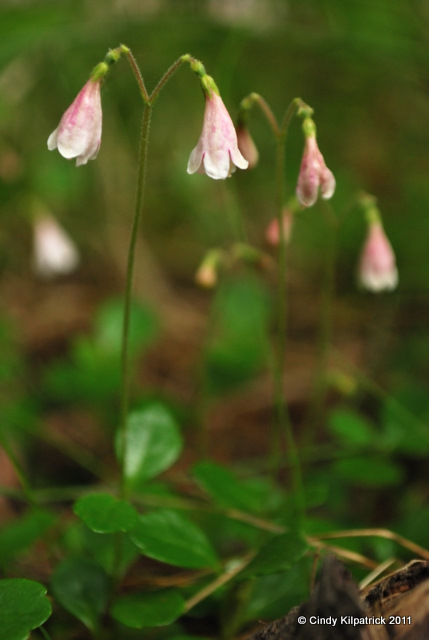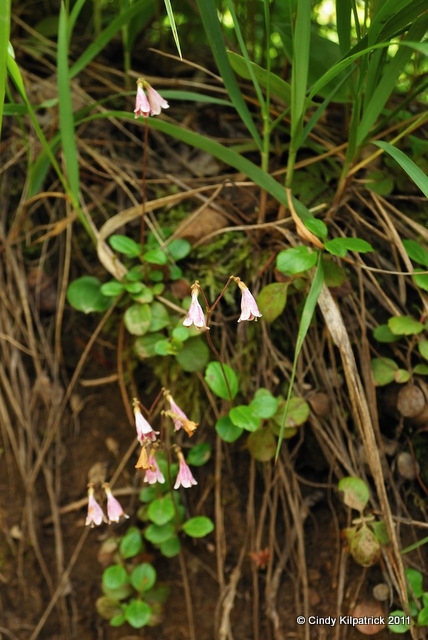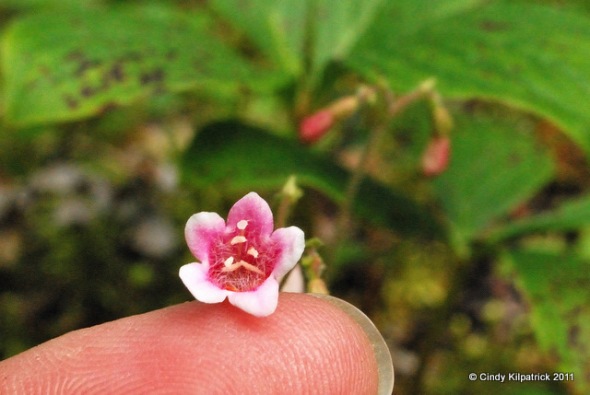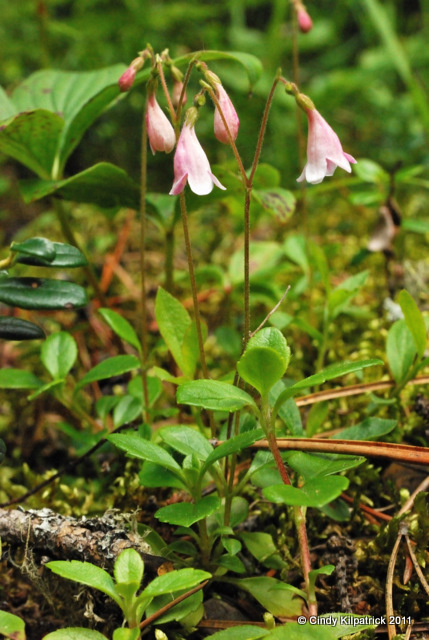Twinflower
or Linnaea, Deer Vine, Ground Vine, Twin Sisters
Linnaea borealis
Delicate and diminutive, this distinctive member of the honeysuckle family grows with the moss among lingonberry and bunchberry. It spreads along the forest floor on lacy vines, sending up clonal shoots at intervals.The Dena’ina name for this sweetly fragrant plant is “k’ela tl’lia” or “mouse’s rope”, a fitting description of the meandering vines depicted well on this page.
This charming plant is circumpolar, but is distinguished by continent. It is interesting and perhaps a warning for other varieties that the subspecies borealis growing in Scotland is threatened by its increasing inability to reproduce due to the fragmentation of its ecosystem. (Read more here.) It is listed as threatened, endangered or extirpated through much of the United States. (link)
Twinflower was the favourite plant of Carlolus Linnaeus, who established the two-name (binomial) system of classification for plants. It was his teacher who officially named the genus, (whose only species member is the twinflower), after Linnaeus and when the latter scientist adopted it as his personal emblem, he said of it, “Linnaea was named by the celebrated Gronovius and is a plant of Lapland, lowly, insignificant, disregarded, flowering but for a brief time—from Linnaeus, who resembles it” (Wikipedia)
Blooming in the early to mid-summer, the elegant twinflower was used by First Nations people for a calming and healing tea. It likes partly shaded areas where the moss is moist and the shed evergreen needles acidify the humus somewhat.
He saw beneath dim aisles, in odorous beds,
The slight Linnaea hang its twin-born heads,
And blessed the monument of the man of flowers,
Which breathes his sweet fame through the northern bowers.
~~~~~~~~~~~~~~~~~~~~~~~~~~~~~~~~~~~~~~~~~~~~~~~~~~~~~~~~~~~~~~~~~~~~~~~~
Other resources:
Plants of the Western Boreal Forest & Aspen Parkland by Derek Johnson et al. Lone Pine, Alberta 1995
Wildflowers of Alberta by R.G.H. Cormack. Hurtig, Alberta 1977
Common Plants of the Western Rangelands: Volume 3 – Forbs by Kathy Tannas. Olds College, Alberta 2004
Wildflowers of the Canadian Rockies by George & Hälle Flygare. Hurtig, Alberta 1986









There low upon the forest floor the stealth observer might catch a glimpse
of fairies dancing amongst the Twinflower. For it is well known, to all fashionable fairies, where the best pink-frilled frocks will grow!
(Sorry, I couldn’t help myself.) ~ L
August 21, 2011 at 11:01 am
Oh I love it Lynda! Thank you.
August 21, 2011 at 11:05 am
Mouse Rope — love that name. I think we have this plant here in Nova Scotia. I’ll have to root through my flower pics to see if I have a photo so I can confirm it’s the one.
Lovely and informative post.
August 22, 2011 at 5:18 am
I enjoyed learning this First Nations name for this sweet plant – it really is so fitting. I don’t know of any plant that you could mistake this for. Its twin blossoms are tiny, but eye-catching in their grace and delicacy. You might see the ‘rope’ curving gently as it grows out over your path at this time of year, the blooms long gone. Let me know if you find it in your flower pics.
August 28, 2011 at 7:54 pm
The write up on this little bit of creation is really appreciated Cindy. In my efforts of this past summer, I thought I was just going to capture plants and blooms to pictures. But as you more elequently point out, it is in “getting to know” these natural beauties that has been most rewarding. No matter what corner of this round planet that we occupy, the fragile reality of the eco-system and the affect that human “progress” has on it is keen to the survival of all creation. As for your current photos, the third capture in the post really brings forth the number, variety and fragile nature of these delicate plants. Very well depicted. Thanks again for sharing.
September 25, 2011 at 7:04 pm
I heartily agree, Jim. It’s not enough to just identify the plants. Understanding the importance how they fit into the ecosystem and how animals and humans have found them beneficial (or hazardous) truly gives an intimacy with nature that goes beyond simple pleasure. Unfortunately this summer was taken up with a work-related project and I didn’t get to spend the time I wanted in the bush, or online building this ‘catalogue’ or checking through others’ explorations. The project is getting back to normal hours now and I am looking forward to catching up on your beautiful and informative posts. Thank you very much for your thoughful comment.
September 26, 2011 at 6:38 am